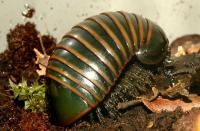|
Grade 3 Science Unit 7 A Bug's Life |
 |
|
Essential Question:
How can we support the conclusion that these organisms are alive? How do recycling and composting help our environment? |
|
| Enduring Understandings | Resources |
|
Minute Organisms Living organisms use different mechanisms to meet their basic needs. |
Producers, Consumers, and Decomposers Game Students will practice identifying producers, consumers and decomposers within this game. Parts of the Food Chain (Consumers, Producers,...) Students will gather information about each part of the food chain from this link. (Goes with the game listed above.) All About Me Students can complete the modified Wanted Poster for another living organism chosen by the teacher. (If the link does not open, login to aacps.discoveryeducation.com) (If the link does not open, login to aacps.discoveryeducation.com) |
|
Recycling & Composting Materials continue to exist, even though they change forms. |
Analyze how living things change their environment as they meet their needs. Drinking Water: Bottled or From the Tap (If the link does not open, login to aacps.discoveryeducation.com) (If the link does not open, login to aacps.discoveryeducation.com) Recycling Story Students can follow the story of a town damaged by pollution from a nearby factory. Recycling Facts Students read to understand how creating things from recycled materials conserves energy.
Recycle City Students will identify ways to recycle and how it affects different parts of a city.
Recycle Zone Students will choose one option from each of the three R's to complete a strategy plan (Pixie) for their school.
|
| Required Lab: It's Alive! |
Resources |
| Student Outcome: Identify reasons to support that brine shrimp are alive by making observations. |
It's Alive
Lab Sheet Record data of observations from a microscope. |
| Project: C is for Compost |
Resources |
|
Student Outcome: Observe activity of organisms found in compost using a hand lens and flashlight.
|
Possible
Resources for Student Research: Consult with media specialists
for online database resources and books
|
| Teacher Resources | |
| Curriculum Links | Resources |
|
Readings, Lesson Plans, SMARTBoard Lessons, and Websites |
Is it Alive? This video includes some "fuzzy" examples that will make students question the meaning of life. Living Things Power Point- Identify characteristics of Living Things. If the Power Point will not play all the way through, right click > save target as > save to the student drive for future use. How Many Years to Disappear? Help understand how long it takes for trash to disappear. |
August 2013
| Teacher Notes | |
| Standards | Resources |
|
Content Standard:
3.B.1.a Use magnifying instruments to observe and describe using drawings or text (oral or written) minute organisms, such as brine shrimp, algae, aphids, etc. that are found in different environments.
5.A.1.a Select relevant information from technology resources. |
(If the link does not open, login to aacps.discoveryeducation.com) Is it Alive? All About Me All About Me Yeast Lab Sheet Microscope Observation Lab Sheet Characteristics of Living Things |
|
Content Standard:
3.B.1.b Describe any observable activity displayed by these organisms. Content Standard: 3.B.1.cProvide reasons that support the conclusion that these organisms are alive.
5.A.1.a Select relevant information from technology resources. |
Mealworm
Activity Photos of Live Brine Shrimp |
|
Content Standard:
3.B.1.d Use information gathered about these minute organisms to compare mechanisms they have to satisfy their basic needs to those used by larger organisms.
Technology Standard:
|
Microbes are Animals Too! Careers in Science: Microbiologist |
|
Content Standard:
3.E.1.a Identify and compile a list of materials that can be recycled.
Technology Standard:
|
Planet Pals
(If the link does not open, login to
aacps.discoveryeducation.com)
(If the link does not open, login to
aacps.discoveryeducation.com) |
|
Content Standard:
3.E.1.b Identify what happens to materials when they are recycled.
Technology Standard:
|
How Many Years to Disappear? Resources - Renewable and Nonrenewable Natural Resources |
|
Content Standard:
3.E.1.c Observe and record the sequence of changes that occur to plants and animals that die and decay.
Technology Standard:
|
Producers, Consumers, and Decomposers Game Producers, Consumers, and Decomposers Game (If the link does not open, login to aacps.discoveryeducation.com) (If the link does not open, login to aacps.discoveryeducation.com) |
|
Content Standard: 3.E.1.d Ask and develop possible answers to questions about what happens to the materials that living things are made of when they die.
Technology Standard:
|
|
August 2015